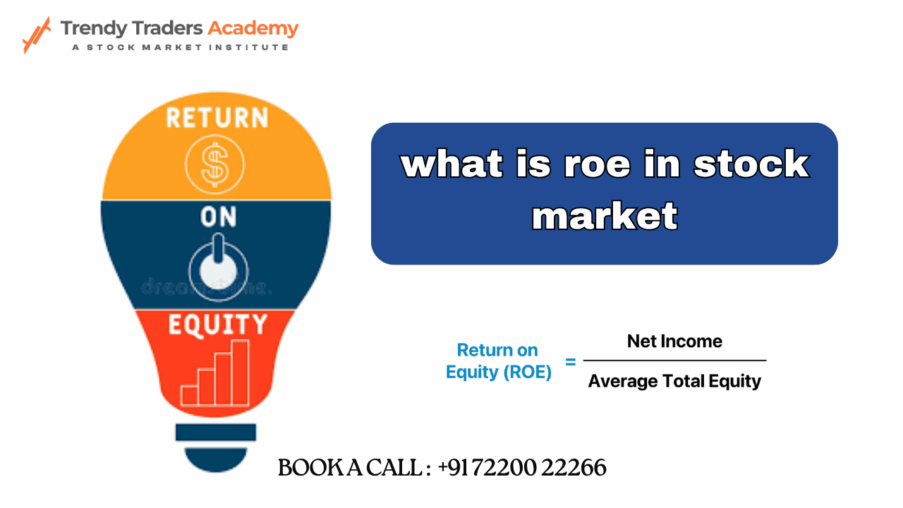What is ROE in Stock Market?
Introduction
Have you ever wondered how experts evaluate whether a company is doing well or not? One of the key financial tools used by investors is something called ROE, or Return on Equity. If you’re new to the stock market, don’t worry. We’re going to break it down in simple, human language—no complicated finance lingo here.
Think of ROE as a report card for a company’s efficiency. It tells you how good the company is at using the money shareholders have invested to generate profits. Kind of like checking how smartly someone spends their allowance to make more money.
By the end of this article, you’ll understand what is ROE in stock market, why it matters, and how it connects to modern investing tools like the best algo trading software in India.
Understand what is ROE in stock market in simple terms. Learn how it’s useful for investors and explore the best algo trading software in India today.
What Does ROE Mean?
Return on Equity (ROE) is a measure of a company’s profitability in relation to shareholders’ equity. In simpler terms, it tells you how much profit a company makes with the money that investors have put in.
Imagine you gave your friend ₹1,000 to start a small business, and after a year, they earned ₹200 profit. That means your friend had a 20% ROE. Not bad, right?
How is ROE Calculated?
Here’s the straightforward formula:
ROE = Net Income / Shareholder’s Equity
Let’s say a company makes ₹10 crore in profit and has ₹50 crore in equity. Its ROE would be:
ROE = 10 / 50 = 0.20 or 20%
This means for every ₹1 of equity, the company generates ₹0.20 in profit.
Why ROE Matters to Investors
ROE is important because it shows how efficiently a company uses investors’ money to generate profits. A consistently high ROE can be a sign of:
- Good management
- Strong business model
- Sustainable profits
When comparing companies, a higher ROE often indicates better performance.
Understanding the ROE Formula
Let’s break down the formula:
- Net Income: The profit after all expenses, taxes, and costs.
- Shareholder’s Equity: The company’s assets minus its liabilities. It’s essentially what the company “owns” outright.
Together, they help investors see the return on their investment in the company.
High vs Low ROE: What’s Better?
High ROE (15% or more) is generally considered good—it shows the company is making good use of its resources.
Low ROE (under 10%) could mean the company isn’t very efficient, or it might be struggling.
But remember, ROE should never be looked at in isolation.
Real-Life Example of ROE
Let’s take two Indian companies:
- Company A earns ₹100 crore profit with ₹500 crore equity → ROE = 20%
- Company B earns ₹100 crore profit with ₹1000 crore equity → ROE = 10%
Even though both make the same profit, Company A is using its resources better.
Limitations of ROE
ROE isn’t perfect. It can be misleading in cases where:
- Companies have very little equity (which inflates ROE)
- There’s a lot of debt, making returns look better than they are
- One-time gains boost profits temporarily
Always check other financial metrics along with ROE.
ROE vs Other Financial Ratios
ROE is great, but here’s how it compares:
| Ratio | What it Measures |
| ROE | Profitability for shareholders |
| ROA (Return on Assets) | Efficiency of all assets |
| ROI (Return on Investment) | Profitability of investment |
| Debt-to-Equity | Financial leverage and risk |
Use them together to get a full picture.
How ROE Affects Stock Prices
Investors love companies that consistently deliver strong ROE. Why?
Because these companies are seen as efficient, profitable, and trustworthy.
This often leads to higher demand for the stock, which can push prices up.
How to Use ROE in Your Investment Strategy
Here’s how you can put ROE to work:
- Compare ROE across companies in the same sector
- Look for consistent ROE over 5–10 years
- Avoid companies with extremely high ROE and lots of debt
ROE can be a helpful filter when choosing stocks.
Common Misconceptions About ROE
Some people think:
- High ROE = always good (Not if driven by debt)
- Low ROE = always bad (Some industries naturally have low ROE)
- ROE alone is enough (You need to look at other factors too)
Don’t fall into these traps.
Role of Algo Trading in ROE-Based Decisions
Algorithmic trading, or algo trading, uses computer programs to make fast trading decisions.
Some algorithms are designed to track ROE and other financial metrics to pick stocks. That means even beginners can use data-driven insights without doing all the number crunching.
Best Algo Trading Software in India
Quanttrix is an Indian algorithmic trading platform designed for both retail and professional traders. It offers advanced tools for strategy building, backtesting, and automated trading without requiring deep programming knowledge. Quanttrix supports integration with multiple brokers, allowing users to execute trades seamlessly based on predefined algorithms. The platform also provides real-time data analytics, risk management features, and a user-friendly dashboard. It’s particularly useful for those looking to automate their trading strategies using technical indicators and market conditions. Quanttrix aims to make algo trading accessible, efficient, and scalable for traders in India’s growing financial markets.
Combining ROE with Algorithmic Trading
Here’s the magic: when you combine ROE analysis with automated trading, you get the best of both worlds:
- ROE helps you find profitable companies.
- Algo trading helps you act on that data, instantly.
It’s like having a financial analyst and a robot working together!
Conclusion and Key Takeaways
To sum it all up:
- ROE is a simple yet powerful tool to judge a company’s profitability.
- It shows how well a business uses investor money.
- A high ROE is good, but only when backed by low debt and consistent performance.
- Pairing ROE insights with the best algorithmic trading software in India makes stock picking smarter and faster.
Whether you’re a casual investor or planning a more data-driven approach, ROE is your best friend in the stock market.
FAQs
What is a good ROE in the stock market?
A good ROE is typically 15% or higher, but this can vary by industry. Always compare with similar companies.
Can a company have negative ROE?
Yes, if a company has negative net income or losses, its ROE can be negative, indicating poor performance.
Is high ROE always a good thing?
Not necessarily. High ROE driven by excessive debt or one-time gains may be risky.
How can beginners use ROE in stock selection?
Start by looking for companies with consistent ROE over several years and low debt levels. Use it with other metrics.
What’s the connection between ROE and algorithmic trading?
Many algorithms use ROE as part of their decision-making criteria to filter quality stocks automatically.




